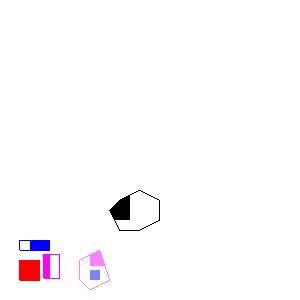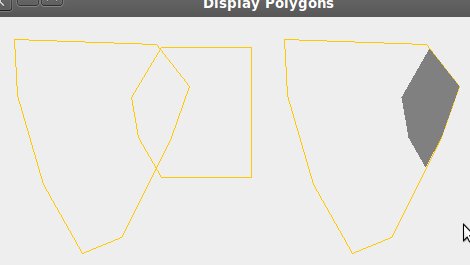/
// Clipper.java
//
//
/**
* Object for performing clipping
*
*/
public class clipper {
/**
* clipPolygon
*
* Clip the polygon with vertex count in and vertices inx/iny
* against the rectangular clipping region specified by lower-left corner
* (x0,y0) and upper-right corner (x1,y1). The resulting vertices are
* placed in outx/outy.
*
* The routine should return the with the vertex count of polygon
* resultinhg from the clipping.
*
* @param in the number of vertices in the polygon to be clipped
* @param inx - x coords of vertices of polygon to be clipped.
* @param int - y coords of vertices of polygon to be clipped.
* @param outx - x coords of vertices of polygon resulting after clipping.
* @param outy - y coords of vertices of polygon resulting after clipping.
* @param x0 - x coord of lower left of clipping rectangle.
* @param y0 - y coord of lower left of clipping rectangle.
* @param x1 - x coord of upper right of clipping rectangle.
* @param y1 - y coord of upper right of clipping rectangle.
*
* @return number of vertices in the polygon resulting after clipping
*
*/
public float intersectX;
public float intersectY;
public float clipXmin;
public float clipYmin;
public float clipYmax;
public float clipXmax;
public int clipBorder;
public int clipPolygon(int in, float inx[], float iny[], float outx[],
float outy[], float x0, float y0, float x1, float y1)
{
int numberOfVerticies = 0;
int n;
float Lx,Ly,Cx,Cy;
Lx = inx[in-1];
Ly = iny[in-1];
for (n = 0; n < in; n++){
Cx = inx[n];
Cy = iny[n];
if(isInside(Cx, Cy, clipBorder)){
if(isInside(Lx,Ly,clipBorder)){
outx[numberOfVerticies] = Cx;
outy[numberOfVerticies] = Cy;
numberOfVerticies++;
}
else{
isIntersect(Lx,Ly,Cx,Cy,clipBorder);
outx[numberOfVerticies] = intersectX;
outy[numberOfVerticies] = intersectY;
numberOfVerticies++;
outx[numberOfVerticies] = Cx;
outy[numberOfVerticies] = Cy;
numberOfVerticies++;
}
}
else{
if(isInside(Lx,Ly,clipBorder)){
isIntersect(Lx,Ly,Cx,Cy,clipBorder);
outx[numberOfVerticies] = intersectX;
outy[numberOfVerticies] = intersectY;
numberOfVerticies++;
}
}
Lx = Cx;
Ly = Cy;
}
return numberOfVerticies; // should return number of verricies in clipped poly.
}
public boolean isInside(float newX, float newY, int clipBorder){
if(clipBorder == 0 && newY > clipYmin){
return true;
}
else if(clipBorder == 1 && newX > clipXmin){
return true;
}
else if(clipBorder == 2 && newY < clipYmax){
return true;
}
else if (clipBorder == 3 && newX < clipXmax){
return true;
}
return false;
}
public void isIntersect(float x0, float x1, float y0, float y1, int clipBorder){
float xDifference = x1 -x0;
float yDifference = y1 - y0;
if(xDifference == 0 || yDifference == 0){
if(clipBorder == 0){
intersectX = x0;
intersectY = clipYmin;
}
else if(clipBorder == 1){
intersectX = clipXmin;
intersectY = y0;
}
else if(clipBorder == 2){
intersectX = x0;
intersectY = clipYmax;
}
else if(clipBorder == 3){
intersectX = clipXmax;
intersectY = y0;
}
return;
}
if(clipBorder == 0){
//intersectX = x0 + ((((((int)xDifference) * ((int)clipYmin - (int)y0))<<8) / ((int)yDifference))>>8);
intersectX = x0 + ((clipYmax - y0)/(y1-y0/x1-x0));
intersectY = clipYmin;
}
else if(clipBorder == 1){
intersectX = clipXmin;
intersectY = (y1-y0/x1-x0)*(clipXmax-x0) + y0;
//intersectY = y0 + ((((((int)yDifference) * ((int)clipXmin - (int)x0))<<8) / ((int)xDifference))>>8);
}
else if(clipBorder == 2){
//intersectX = x0 + ((((((int)xDifference) * ((int)clipYmax - (int)y0))<<8) / ((int)yDifference))>>8);
intersectX = x0+((clipYmin-y0)/(y1-y0/x1-x0));
intersectY = clipYmax;
}
else if(clipBorder == 3){
intersectX = clipXmax;
//intersectY = y0 + ((((((int)yDifference) * ((int)clipXmax - (int)x0))<<8) / ((int)xDifference))>>8);
intersectY = (y1-y0/x1-x0)*(clipXmax-x0) + y0;
}
}
}
The main and the other classes are in this download.
http://www.megafileupload.com/en/file/383064/cg1-clip-zip.html


